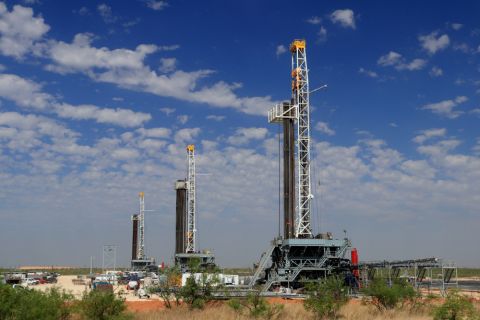
During SM Energy’s first-quarter earnings call, CEO Jay Ottoson shared his disappointment with investors over recent stock underperformance despite the Permian Basin producer’s strong results. (Source: Shutterstock.com)
[Editor's note: A version of this story appears in the June 2019 edition of Oil and Gas Investor. Subscribe to the magazine here.]
Equities, in general, are supposed to discount future market conditions, and that’s why price targets are usually set on metrics projected for 2020, for example, rather than what is forecast for the next quarter or two. But energy equities have a shallow set of buyers, and trading strategies have found it often possible to make money selling stocks short ahead of quarterly conference calls.
It’s hard to find a CEO today who is unaware of investor pressure on E&Ps to spend within cash flow and, as soon as possible thereafter, generate free cash flow. Also, it’s sometimes hard to know exactly what drives a company’s stock price, even if you’re a CEO who knows which levers logically should deliver stock price performance. Take, for instance, first-quarter results by SM Energy Co.
“We are so close to growing within cash flow that we can almost taste it,” said Jay Ottoson, SM Energy’s CEO, noting his shared disappointment with investors over recent stock underperformance. Even with key quarterly metrics pre-announced—and incremental news being decidedly positive on drilling developments—SM’s stock fell a further 9% at one point on the day of its earnings release.
RELATED: SM Energy Works To Prove Up Permian Basin, Austin Chalk Inventory
The stock move was a bit of a head scratcher, noted one research house.
“We view the selloff here as overdone, particularly given the company’s operations update this quarter, which quite frankly was one of the strongest we’re seen this year,” read a J.P. Morgan report. “Not only is the company’s Merlin Maximus development tracking in-line with the company’s Wolfcamp A vintages, the company also had some intriguing results from the Wolfcamp D, Dean and Middle Spraberry in its RockStar area, which was once believed to be a one or two bench play.”
Back at the helm of Pioneer Natural Resources Co., CEO Scott Sheffield took time to find his footing against a backdrop of heightened expectations. Despite a beat on cash flow per share, plus a move to prioritize free cash flow by trimming growth targets to “mid-teens” from a prior 20% level, Pioneer’s results fell short of expectations, with its stock down 8% at its intra-day low.
Obviously, candor on the part of Sheffield—recalling, “I didn’t come back to sell the company”—may have prompted some investors to exit. As a Bernstein report commented, “Investors may have suspected a revolution; instead, they got an evolution,” implying Pioneer’s future would depend less on moves to consolidate the Permian and more on a path of moderate growth to deliver returns to investors.
On M&A, “I personally don’t think that there’s going to be a lot of M&A over the next one to two years,” said Sheffield. However, “over the next five years, I think the majors will definitely start running out of inventory,” he observed. Meanwhile, “smaller companies in the Permian are going to have to consolidate” to achieve lower general and administrative expenses and a better cost structure.
A clear winner in the short-term tumble of earnings season was Diamondback Energy Inc. Fast footwork late last year, as crude prices plummeted, led to it cutting three rigs and two spreads in the first quarter. Coupled with ongoing efficiencies in the Midland Basin, where drilling and completion costs came down 15% and 9% from the prior quarter, the result was capex that was 15% below consensus.
But the highlight of the quarter was Diamondback’s announcement of a $2 billion stock buyback, or 12% of its market capitalization, based on its free-cash-flow outlook through year-end 2020. At $55 West Texas Intermediate, the company projects to generate “at least $750 million of free cash flow in 2020.” In addition, it announced $322 million in noncore asset sales, expected to close on July 1.
“The signal that we’ve put forth today is that we believe that repurchasing our shares represents the greatest value on the M&A front, and that’s a $2 billion acquisition that we’re talking about,” said Travis Stice, CEO of Diamondback Energy. “This is not just a one-time event; this is the board signaling that this is an ongoing return-of-capital strategy.”
Diamondback’s stock performance, closing up 7.7% after its earnings release, stood out amid overall energy sector volatility. A review by RBC Capital Markets indicated that more than 70% of its coverage traded lower on earnings, even as 90% of companies met or exceeded cash flow per share estimates.
How did it describe investor sentiment? “Challenging.”
Chris Sheehan can be reached at csheehan@hartenergy.com.
Recommended Reading
Hess: Pre-emption Provision Doesn't Apply to Buyout Deal With Chevron
2024-02-27 - Hess Corp. said on Feb. 27 that a pre-emption provision does not apply to its proposed $53-billion buyout by Chevron Corp. and it remains "fully committed" to the deal.
EQT, Equitrans Midstream to Combine in $5.5B Deal: Reports
2024-03-11 - EQT Corp.'s deal would reunite the natural gas E&P with Equitrans Midstream after the two companies separated in 2018.
Marketed: Anschutz Exploration Corp. WI Opportunity in Converse County, Wyoming
2024-01-26 - Anschutz Exploration Corp. retained EnergyNet for the sale of its WI participation option in Converse County, Wyoming.
Excelerate Energy, Qatar Sign 15-year LNG Agreement
2024-01-29 - Excelerate agreed to purchase up to 1 million tonnes per anumm of LNG in Bangladesh from QatarEnergy.
UK’s Union Jack Oil to Expand into the Permian
2024-01-29 - In addition to its three mineral royalty acquisitions in the Permian, Union Jack Oil is also looking to expand into Oklahoma via joint ventures with Reach Oil & Gas Inc.


